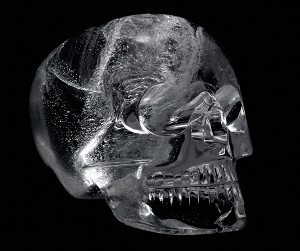Whatever the case, the crystal rock skull is cut and polished so perfectly that it appears to be an invaluable work of art. However, to be certain of the first hypothesis (that the skull is Mayan in origin) we are faced with a series of penetrating questions.
The Skull of Destiny is, in a certain sense, a technical impossibility. With a weight of around 5kg (11 lbs) and being a perfect replica of a female skull, it has a finish that would have been impossible to achieve without relative modern methods, according to scientists; methods that, of course, the Mayan culture is not known to have possessed.
This skull has been (and probably will continue to be to a lesser degree) something of an attraction to specialists from various disciplines for many years - notwithstanding the expected attribution of these kinds of works to "ancient esoteric groups" with "supernormal powers" like telekinesis.

|
| ©AFP/Getty Images |
| One of the controversial "crystal skulls" on display in the British Museum. |
The skull was subject to different analyses. One of the unsolved mysteries is that being quartz crystal, and consequently having a hardness rating of 7 on the Mohs scale (scale of hardness of elements from 0 to 10) it is astonishing that it could have been carved without hard modern tools made of substances like ruby or diamond. Studies of the skull made in the 1970s by the American company Hewlett-Packard determined that the skull would have had to have been polished by sand erosion for a period of 300 years to reach such a degree of perfection.
Could the Mayans have consciously planned a work of this sort, prepared to wait three centuries to see it completed? One certain thing is that the Skull of Destiny is not the only one of its kind. Several of these objects were found in different parts of the world and were constructed of materials other than quartz. Even an entire skeleton of jade, on a scale smaller than human, was found in the region of China/Mongolia. Its age is estimated to be around 2200 to 3500 years B.C.E.
Of course, there are those who doubt the authenticity of many of these artifacts - but there is something that is undeniable: the phenomena of crystal skulls and other like artifacts will continue to be a subject of interest for investigators.



Reader Comments
to our Newsletter